Festival 1 Endocrine & Blood
Chapters 16, 17
Both "turn on" factors (hormonal, humoral, and neural stimuli) and "turn off" factors (feedback inhibition and others) may be modulated by the activity of the nervous system.
True
False
True
All peptide hormone synthesis requires gene activation that produces mRNA.
True
False
True
Specifically, what is the production of red blood cells called?
leukopoiesis
thalassemia
hemostasis
erythropoiesis
erythropoiesis
Oxytocin is a strong stimulant of uterine contractions.
True
False
True
Which plasma constituent is the main contributor to osmotic pressure?
alpha globulins
albumin
fibrinogen
beta globulins
albumin
What organ in the body regulates erythrocyte production?
brain
pancreas
liver
kidney
kidney
ACTH stimulates the adrenal cortex to release corticosteroid hormones.
True
False
True
Which of the following might trigger erythropoiesis?
an increased number of RBCs
hypoxia of EPO-producing
cells
moving to a lower altitude
decreased tissue demand for oxygen
hypoxia of EPO-producing cells
In adults, red blood cell production occurs in __________.
the liver
red bone marrow
yellow bone
marrow
the thymus
red bone marrow
Diapedesis is the process by which red blood cells move into tissue spaces from the interior of blood capillaries.
True
False
False
Leukemia refers to cancerous conditions involving white blood cells.
True
False
True
Major hormones circulate to virtually all tissues.
True
False
True
Which of the following is a hormone produced by the posterior pituitary?
oxytocin
ADH
HGH
none of these
none of these
What is hematocrit a measure of?
Hematocrit is the percentage of leukocytes and platelets in a
whole blood sample.
Hematocrit is the percentage of formed
elements in a whole blood sample.
Hematocrit is the percentage
of plasma in a whole blood sample.
Hematocrit is the percentage
of erythrocytes in a whole blood sample.
Hematocrit is the percentage of erythrocytes in a whole blood sample.
Positive chemotaxis is a feedback system that signals leukocyte migration into damaged areas.
True
False
True
The stimuli causing endocrine glands to secrete their hormones in direct response to changing blood levels of certain critical ions and nutrients are called __________.
humoral stimuli
neural stimuli
hormonal
stimuli
endocrinal stimuli
humoral stimuli
Which of the following does NOT stimulate erythrocyte production?
a drop in normal blood oxygen levels
erythropoietin
testosterone
hyperventilating
hyperventilating
Which hypothalamic hormone stimulates the release of growth hormone from the anterior pituitary (lobe)?
thyroid-stimulating hormone (TSH)
adrenocorticotropic
hormone (ACTH)
growth hormone-inhibiting hormone
(GHIH)
growth hormone-releasing hormone (GHRH)
growth hormone-releasing hormone (GHRH)
The second-messenger mechanism of hormone action operates by ________.
altering gene expression in the nuclear DNA
increasing
the basal metabolic rate in the target organ
synthesizing more
than one hormone at a time
binding to specific receptors and
employing the services of G proteins and cAMP
binding to specific receptors and employing the services of G proteins and cAMP
Which type of leukocyte is responsible for antibody production?
eosinophils
lymphocytes
monocytes
basophils
lymphocytes
In circumstances where the body requires prolonged or increased levels of a hormone, the DNA of target cells will specify the synthesis of more receptors on the surface of the cells of the target organ. This is known as ________.
a stressor reaction
cellular affinity
sensitivity increase
up-regulation
up-regulation
Each hemoglobin molecule can transport two molecules of oxygen.
True
False
False
Hypersecretion of what hormone can produce the effects of gigantism (individual in the center of this image)?
growth hormone (GH)
aldosterone
thyroid hormones
(TH)
thyroid-stimulating hormone (TSH)
growth hormone (GH)
Hormones are long-distance chemical signals that travel in blood or lymph throughout the body.
True
False
True
Thyroid hormone (a small iodinated amine) enters target cells in a manner similar to ________.
insulin, because insulin is a small peptide
glucagon,
because the structure of glucagon is similar to that of thyroid
hormone
growth hormone, because the thyroid works synergistically
with thyroid hormone
steroid hormones, because both diffuse
easily into target cells
steroid hormones, because both diffuse easily into target cells
Which of the following is characteristic of all leukocytes?
They have cytoplasmic granules.
They are
phagocytic.
They are nucleated.
They are the most numerous
of the formed elements in blood.
They are nucleated.
What is the primary function of hormones?
alter cell activity
activate extracellular
enzymes
cause allergic reactions
influence metabolic
activity of glands by electrochemical impulses
alter cell activity
Which of the following is NOT a property of endocrine glands?
They drain vascularly.
They drain
lymphatically.
They have ducts.
They produce hormones.
They have ducts.
What do the lymphoid stem cells give rise to?
erythrocytes
monocytes
lymphocytes
granulocytes
lymphocytes
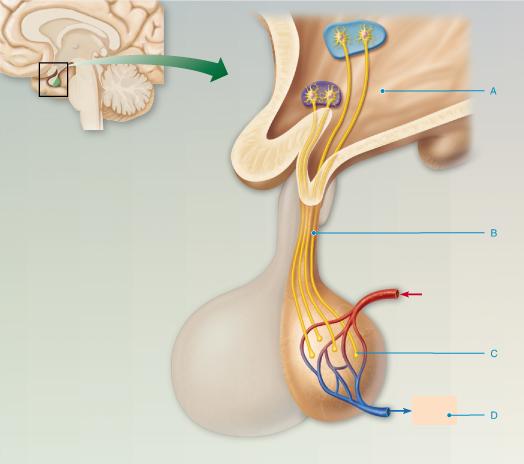
Where are the hormones oxytocin and antidiuretic hormone (ADH) stored? Select from letters A-D.
A
B
C
D
C
Which of the following hormones helps the body avoid dehydration and water overload?
thyroid-stimulating hormone
antidiuretic
hormone
follicle-stimulating hormone
oxytocin
antidiuretic hormone
Which of the following glands is found atop the kidneys?
pituitary
parathyroid
thyroid
adrenal
adrenal
Which of the following is best suited to the clotting process that occurs when blood vessels are ruptured?
lymphocytes
megakaryoblast
platelets
megakaryocyte
platelets
Which of the following is true about blood plasma?
It is the same as serum but without the clotting
proteins.
It is about 90% water.
It contains about 20
dissolved components.
The main protein component is hemoglobin.
It is about 90% water.
Which of the following is NOT a major type of stimulus that triggers endocrine glands to manufacture and release hormones?
hormonal
enzymatic
humoral
neural
enzymatic
The major targets of growth hormone are ________.
kidneys
the adrenal glands
bones and skeletal
muscles
the blood vessels
bones and skeletal muscles
What is required for the production of anterior pituitary gland hormones?
humoral stimuli
neural stimuli (from the sympathetic
division of the ANS)
hormonal stimuli
all of these
hormonal stimuli
The first step in hemostasis is __________.
platelet plug formation
coagulation
fibrin
production
vascular spasm
vascular spasm
In a centrifuged sample of blood, what makes up the buffy coat?
red blood cells
plasma
platelets only
white
blood cells and platelets
white blood cells and platelets
Thyroxine is a peptide hormone, but its mechanism is different from other peptide hormones. Which of the following statements is true concerning this difference?
It is very specific in the cell type it targets.
It is a
stimulant of cellular metabolism and targets all cells.
It causes
positive feedback.
It does not require a second messenger to
effect a response.
It does not require a second messenger to effect a response.
The endocrine gland that is probably malfunctioning if a person has a high metabolic rate is the parathyroid.
True
False
False
Platelets ________.
stick to the damaged area of a blood vessel and help seal the
break
have a life span of about 120 days
have multiple
nuclei
are the precursors of leukocytes
stick to the damaged area of a blood vessel and help seal the break
Which of the following is NOT a function of blood?
distribution
regulation
hormone production
protection
hormone production
Direct gene activation involves a second-messenger system.
True
False
False
The majority of whole blood is __________.
erythrocytes
plasma
platelets
leukocytes
plasma
Which of the following is not a change typically produced by a hormonal stimulus?
stimulates production of an action potential
activates
or deactivates enzymes
induces secretory activity
alters
plasma membrane permeability
stimulates production of an action potential
Which of the following hormones mainly serves to stimulate milk production by the breasts?
thyroid-stimulating hormone
follicle-stimulating
hormone
adrenocorticotropic hormone
prolactin
prolactin
Virtually all of the protein or amino acid-based hormones exert their effects through intracellular ________.
deactivating ions
calcium
nucleotides
second messengers
second messengers
What part of the pathway to produce platelets is shared with other formed elements?
megakaryoblast
hematopoietic stem cell
(hemocytoblast)
lymphoid stem cell
reticulocyte
hematopoietic stem cell (hemocytoblast)
Which of the formed elements contains hemoglobin and transports respiratory gases?
agranular leukocytes
granular leukocytes
platelets
erythrocytes
erythrocytes
Festival 2 Heart
Chapter 18
Anastomoses among coronary arterial branches provide collateral routes for blood delivery to the heart muscle.
True
False
True
The left side of the heart is considered the systemic circuit pump.
True
False
True
What causes normal heart sounds?
cardiac muscle contraction
opening of heart
valves
heart valve closure
pressure of blood in the ventricles
heart valve closure
The P wave of a normal electrocardiogram indicates ________.
atrial depolarization
ventricular
repolarization
ventricular depolarization
atrial repolarization
atrial depolarization
Select the correct statement about the heart valves.
The AV valves are supported by chordae tendineae so that
regurgitation of blood into the atria during ventricular contraction
does not occur.
Aortic and pulmonary valves control the flow of
blood into the heart.
The tricuspid valve divides the left atrium
from the left ventricle.
The mitral valve separates the right
atrium from the right ventricle.
The AV valves are supported by chordae tendineae so that regurgitation of blood into the atria during ventricular contraction does not occur.
Which functional feature best describes the manner in which cardiac muscle contracts?
Nerve fibers must stimulate cardiac muscle cells for them to
contract.
Only some motor units contract in cardiac
muscle.
Automaticity (autorhythmicity) promotes the spontaneous
contraction of the cardiac muscle cells.
Refractory periods in
cardiac contractions are relatively short.
Automaticity (autorhythmicity) promotes the spontaneous contraction of the cardiac muscle cells.
What structures connect the individual heart muscle cells?
chordae tendineae
anastomoses
intercalated
discs
trabaculae carneae
intercalated discs
The first heart sound (the "lub" of the "lub-dup") is caused by __________.
opening of the semilunar valves
opening of the
atrioventricular valves
closure of the atrioventricular
valves
closure of the semilunar valves
closure of the atrioventricular valves
Normal heart sounds are caused by which of the following events?
closure of the heart valves
opening and closing of the
heart valves
excitation of the SA node
friction of blood
against the chamber walls
closure of the heart valves
Consider the following characteristics of the cells found in muscle tissue. Which feature is shared by both cardiac muscle and skeletal muscle?
branched cells
intercalated discs
striations
triads
striations
The term for pain associated with deficient blood delivery to the heart that may be caused by the transient spasm of coronary arteries is ________.
ischemia
angina
pectoris
pericarditis
myocardial infarct
angina pectoris
The fact that the left ventricle of the heart is thicker than the right ventricle reveals that it ________.
expands the thoracic cage
sends blood through a smaller
valve
pumps a greater volume of blood
pumps blood against a
greater resistance
pumps blood against a greater resistance
Which of the following is the outermost covering of the heart?
visceral layer
fibrous pericardium
parietal layer
epicardium
fibrous pericardium
Into which chamber of the heart do the superior vena cava, inferior vena cava, and coronary sinus return deoxygenated blood?
right atrium
right ventricle
left atrium
left ventricle
right atrium
Compared to skeletal muscle, cardiac muscle ________.
cells are larger than skeletal muscle cells
has gap
junctions that allow it to act as a functional syncytium
lacks
striations
has more nuclei per cell
has gap junctions that allow it to act as a functional syncytium
Auricles slightly increase blood volume in the ventricles.
True
False
False
The __________ valve is located between the right atrium and the right ventricle.
mitral
tricuspid
aortic semilunar
pulmonary semilunar
tricuspid
The role of the coronary arteries is to __________.
move blood from the atria to the ventricles
direct blood
to the pulmonary veins
direct blood to the aorta
supply
blood to the heart tissue
supply blood to the heart tissue
Specifically, what part of the intrinsic conduction system stimulates the atrioventricular (AV) node to conduct impulses to the atrioventricular bundle?
interventricular septum
subendocardial conducting network
(Purkinje fibers)
bundle branches
sinoatrial (SA) node
sinoatrial (SA) node
If cardiac muscle is deprived of its normal blood supply, damage would primarily result from ________.
an inadequate supply of lactic acid
a lack of nutrients
to feed into metabolic pathways
a decrease in the number of
available mitochondria for energy production
decreased delivery
of oxygen
decreased delivery of oxygen
Which of the following terms refers to a lack of oxygen supply to heart muscle cells?
infarction
embolism
functional syncytium
ischemia
ischemia
Which of the following structures sets the pace of heart contraction?
AV node
bundle branches
SA
node
atrioventricular bundle
SA node
The order of impulse conduction in the heart, from beginning to end, is __________.
SA node, bundle of His, AV node, bundle branches, and Purkinje
fibers
SA node, bundle branches, AV node, bundle of His, and
Purkinje fibers
SA node, AV node, bundle of His, bundle branches,
and Purkinje fibers
SA node, bundle branches, bundle of His, AV
node, and Purkinje fibers
SA node, AV node, bundle of His, bundle branches, and Purkinje fibers
The heart's pacemaker is the __________.
Purkinje fibers
sinoatrial node
atrioventricular
node
atrioventricular bundle
sinoatrial node
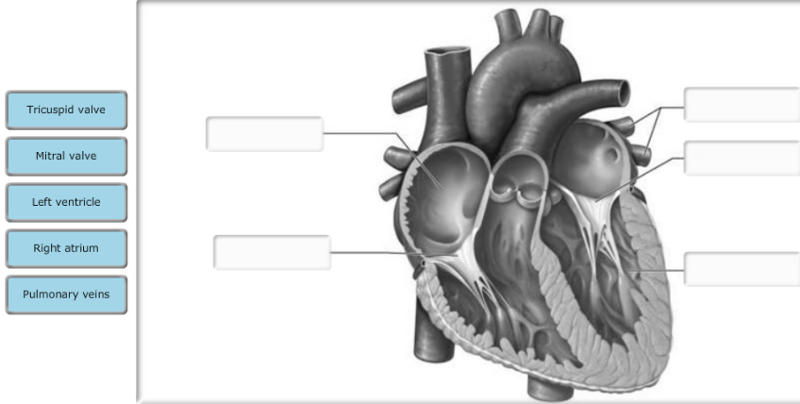
Use the figure to match the following.
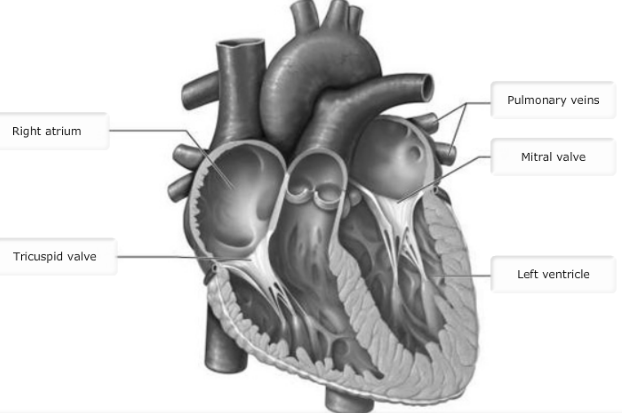
Festival 3 Blood Vessels
Chapter 19
Which of the following is true about veins?
Veins have valves; arteries do not.
Veins have a smaller
diameter lumen than arteries.
Veins are more muscular than
arteries.
Veins carry blood away from the heart, while arteries
carry blood to the heart.
Veins have valves; arteries do not.
The thick-walled arteries close to the heart are called muscular arteries.
True
False
False
Aldosterone will ________.
promote an increase in blood pressure
promote a decrease
in blood volume
decrease sodium reabsorption
result in a
larger output of urine
promote an increase in blood pressure
How would an attack by a mugger affect blood pressure? What is the physiological basis for your answer?
Blood pressure would increase due to parasympathetic nervous
system stimulation.
Blood pressure would decrease due to
parasympathetic nervous system stimulation.
Blood pressure would
increase due to vagal nerve stimulation.
Blood pressure would
decrease due to sympathetic nervous system stimulation.
Blood
pressure would increase due to sympathetic nervous system stimulation.
Blood pressure would increase due to sympathetic nervous system stimulation.
Which of the following chemicals does not help regulate blood pressure?
ADH
atrial natriuretic peptide
angiotensin
II
nitric acid
nitric acid
Which of the following will lower blood pressure?
atrial natriuretic peptide
(ANP)
aldosterone
angiotensin II
antidiuretic hormone (ADH)
atrial natriuretic peptide (ANP)
The inferior vena cava carries blood __________ the __________ of the heart.
to: left atrium
to; right atrium
away from; left
atrium
away from; right atrium
to; right atrium
The outermost layer of a blood vessel is the tunica intima.
True
False
False
What is the outermost layer of the blood vessel wall for an artery or vein?
subendothelial layer
tunica media
tunica
intima
tunica externa
tunica externa
Leaky capillaries found in the bone marrow are called __________.
arterioles
sinusoidal capillaries
fenestrated
capillaries
continuous capillaries
sinusoidal capillaries
Factors that aid venous return include all except ________.
activity of skeletal muscles
venous valves
urinary
output
pressure changes in the thorax
urinary output
What type of vessel has relatively more smooth muscle and less elastic tissue?
elastic artery
capillary
arteriole
muscular artery
muscular artery
Which of the following is true about veins?
Up to 35% of total body blood is in venous circulation at any
given time.
Veins have a small lumen in relation to the
thickness of the vessel wall.
Veins are called capacitance
vessels or blood reservoirs.
Venous valves are formed from the
tunica media.
Veins are called capacitance vessels or blood reservoirs.
Substances absorbed in the intestines would be routed to the liver via the __________.
suprarenal veins
inferior vena cava
abdominal
aorta
hepatic portal vein
hepatic portal vein
Which type of vessel contains elastin in all three tunics to allow the vessel to expand and recoil as the heart ejects blood?
arteriole
muscular artery
elastic
artery
distributing artery
elastic artery
Which of the following is NOT an important source of resistance to blood flow?
total blood volume
blood viscosity
vessel
length
vessel diameter
total blood volume
Which of the following is the most significant source of blood flow resistance?
blood vessel diameter
blood viscosity
total blood
vessel length
blood vessels type
blood vessel diameter
Which of the following is involved in long-term blood pressure regulation?
baroreceptors
renal mechanisms
chemoreceptor
reflexes
higher brain center
renal mechanisms
All capillary beds are continuously perfused with blood.
True
False
False
Vasodilation will result in increased blood flow to a given tissue.
True
False
True
Which of the choices below explains why the arterioles are known as resistance vessels?
They distribute blood to various parts of the body.
They
contain a large quantity of elastic tissue.
Their prime function
is the exchange of nutrients and wastes between the blood and tissue
cells.
The contraction and relaxation of the smooth muscle in
their walls can change their diameter.
The contraction and relaxation of the smooth muscle in their walls can change their diameter.
Which statement best describes arteries?
All contain valves to prevent the backflow of blood.
All
carry oxygenated blood to the heart.
All carry blood away from
the heart.
Only large arteries are lined with endothelium.
All carry blood away from the heart.
Which tunic of an artery is most responsible for maintaining blood pressure and continuous blood circulation?
tunica adventitia
tunica intima
tunica
externa
tunica media
tunica media
What type of tissue is found in the walls of the arteries but not in the walls of capillaries and venules?
endothelium
elastic tissue
smooth muscle
collagen fibers
elastic tissue
Which of the following would experience a decreased blood flow during exercise?
skeletal muscles
kidneys
brain
skin
kidneys
Festival 4 Lymphatics
Chapter 20
Lymphatic collecting vessels are most closely associated with __________.
bone marrow
the heart
arterioles
capillary beds
capillary beds
Once collected, lymph is returned to __________.
venous circulation
the liver for detoxification
the
kidneys for filtration
arterial circulation
venous circulation
Which part of the spleen is the site of immune function?
red pulp
splenic sinusoids
splenic cords
white pulp
white pulp
Large clusters of lymph nodes occur in all of the following locations except the ________.
axillary region
inguinal region
lower
extremities
cervical region
lower extremities
Which of the following is not a part of the lymphatic system?
lymphatic vessels
lymph nodes
lymph
erythrocytes
erythrocytes
Select the correct statement about lymphocytes.
T cells are the precursors of B cells.
The two main types
are T cells and macrophages.
B cells produce plasma cells, which
secrete antibodies into the blood.
T cells are the only form of
lymphocyte found in lymphoid tissue.
B cells produce plasma cells, which secrete antibodies into the blood.
Which of the following is not a function of the lymphatic system?
draining excess interstitial fluid
carrying out immune
responses
transporting respiratory gases
transporting
dietary fats
transporting respiratory gases
Lymph capillary permeability is due to minivalves and protein filaments.
True
False
True
What is a bubo?
an infected Peyer's patch
a wall in a lymph node
a lobe
of the spleen
an infected lymph node
an infected lymph node
The __________ is (are) the most likely to become infected.
pharyngeal tonsil
palatine tonsils
lingual
tonsil
tubal tonsil
palatine tonsils
The filtration of lymph and immune system activation are the two basic functions of the __________.
lymph nodes
Peyer's patches
tonsils
spleen
lymph nodes
What is the main function of the lymphatic system?
The lymphatic system pumps and transports blood throughout the
body.
The lymphatic system returns leaked fluid and plasma
proteins that escape from the bloodstream to the blood.
The
lymphatic system regulates blood pressure through the
renin-angiotensin-aldosterone mechanism.
The lymphatic system
makes blood cells through a process known as hematopoiesis.
The lymphatic system returns leaked fluid and plasma proteins that escape from the bloodstream to the blood.
Like blood, lymph flows both to and from the heart.
True
False
False
Lymph leaves a lymph node via ________.
afferent lymphatic vessels
efferent lymphatic
vessels
the cortical sinus
the subcapsular sinus
efferent lymphatic vessels
Which of the following is NOT a lymphatic cell?
reticular cell
macrophage
dendritic cell
eosinophil
eosinophil
The lymphatic capillaries function to absorb the excess protein-containing interstitial fluid and return it to the bloodstream.
True
False
True
Lymph nodes are surrounded by a capsule from which connective tissue strands extend inward to divide the node into compartments. What is the name of these strands?
hilum
lymph sinuses
medullary cords
trabeculae
trabeculae
Chyle is delivered to the blood via the lymphatic system.
True
False
True
What is the role of the B lymphocytes (B cells) in lymphoid tissue?
manage the immune response
produce plasma cells that secrete
antibodies
capture antigens and bring them back to the lymph
nodes
phagocytize foreign substances
produce plasma cells that secrete antibodies
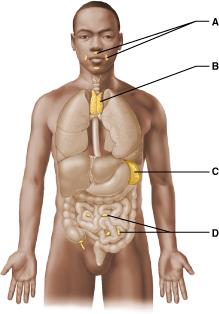
Which of these lymphoid organs destroys bacteria before it can breach the intestinal wall and generates "memory" lymphocytes for long-term memory? Select from letters A-D.
A
B
C
D
D
Lymph capillaries are absent in all except which of the following?
bone marrow
CNS
bones and teeth
digestive organs
digestive organs
About 3 liters of fluid are lost to the tissue spaces every 24 hours and are returned to the bloodstream as lymph.
True
False
True
Where are worn-out erythrocytes found in the spleen?
red pulp
capsule
white pulp
splenic cords
red pulp
What region of the lymph node contains densely packed follicles with dividing B cells?
medulla
cortex
trabeculae
capsule
cortex
Which of the following lymphoid tissues/organs does NOT contain reticular connective tissue?
thymus
spleen
tonsils
lymph nodes
thymus
Festival 5 Immune System
Chapter 21
Small molecules that bind with self-proteins to produce antigenic substances are called ________.
ions
haptens
antibodies
reagins
haptens
Which of the following best illustrates artificially acquired active humoral immunity?
infection
antibodies received in breast milk
antivenoms
vaccines
vaccines
__________ immunity protects a baby who is fed breast milk.
Natural active
Natural passive
Artificial
passive
Artificial active
Natural passive
Which of the following mechanisms of antibody action occur when red blood cells clump due to a transfusion of mismatched blood?
complement fixation and activation
agglutination
neutralization
precipitation
agglutination
Why are children given vaccinations?
to activate the cell-mediated defense against pathogens
to
develop memory cells against various diseases
to see whether the
immune system is capable of defense against disease
to develop a
disease in a mild state rather than have it later on in a more serious state
to develop memory cells against various diseases
Which of the following cells engulf antigens and present fragments of them on their own surfaces, where they can be recognized by cells that will deal with them?
CD8 cells
T lymphocytes
dendritic cells
NK cells
dendritic cells
What is the role of interferon in defense against disease?
activates the complement mechanism
activates the inflammatory
process
to kill the bacteria
protects cells that have not
yet been infected by viruses
protects cells that have not yet been infected by viruses
Which of the following is NOT one of the cardinal signs of inflammation?
swelling
vasoconstriction
redness
heat
vasoconstriction
What mobilizes the adaptive defenses and provokes an immune response?
MHC proteins
pyrogens
interferons
antigens
antigens
Fever ________.
is a higher-than-normal body temperature that is always
dangerous
production is regulated by chemicals that reset the
body's thermostat to a higher setting
causes the liver to release
large amounts of iron, which seems to inhibit bacterial
replication
decreases the metabolic rate of the body to conserve energy
production is regulated by chemicals that reset the body's thermostat to a higher setting
Cellular ingestion and destruction of particulate matter is called phagocytosis.
True
False
True
Which of the following is a part of the second line of defense against microorganisms?
phagocytes
cilia
gastric juice
keratin
phagocytes
Which of the following do NOT serve as antigen-presenting cells (APC)?
macrophages
natural killer cells
B cells
dendritic cells
natural killer cells
Cancer cells and virus-infected body cells can be killed before activation of adaptive immunity by ________.
pinocytosis
T lymphocytes
B lymphocytes
natural
killer cells
natural killer cells
__________ are lymphocytes that directly kill virus- infected cells.
Helper T cells
Macrophages
B cells
Cytotoxic T cells
Cytotoxic T cells
Adaptive immunity is provided only by lymphocytes that secrete antibodies.
True
False
False
Immunocompetence ________.
prevents intercellular communication so that only specific cell
types respond to the invader
occurs in one specific organ of the
adaptive immune system
is the ability of individual cells to
recognize a specific antigen by binding to it
requires exposure
to an antigen
is the ability of individual cells to recognize a specific antigen by binding to it
How would you classify the antivenom used to treat poisonous snake bites?
active immunity, naturally acquired
passive immunity,
naturally acquired
active immunity, artificially
acquired
passive immunity, artificially acquired
passive immunity, artificially acquired
Some immunocompetent cells will never be called to service in our lifetime.
True
False
True
The directional movement of cells in response to chemicals is called chemotaxis.
True
False
True
What is the specific target of interferons?
antibodies
infected cells
nearby healthy
cells
specific viruses
nearby healthy cells
B lymphocytes develop immunocompetence in the ________.
bone marrow
thymus
lymph nodes
spleen
bone marrow
Antigens bound to MHC II activate __________.
B cells
cytotoxic T cells
macrophages
helper T cells
helper T cells
Select the correct statement about antigens.
Only small antigens exhibit
reactivity.
"Self-antigens" is another name for
incomplete antigens.
One antigen may have many different
antigenic determinants and may therefore cause the formation of more
than one antibody.
The largest type of antigen is called a hapten.
One antigen may have many different antigenic determinants and may therefore cause the formation of more than one antibody.
Virus infected cells secrete complement to "warn" other cells of the presence of virus.
True
False
False
Festival 6 Respiratory System
Chapter 22
Which parts of the respiratory system function as the main sites of gas exchange?
primary bronchi
trachea
alveoli
terminal bronchioles
alveoli
Which of the disorders below is characterized by destruction of the walls of the alveoli producing abnormally large air spaces that remain filled with air during exhalation?
coryza
pneumonia
tuberculosis
emphysema
emphysema
Hypoxia can be caused by ______.
hyposecretion of erythropoietin
having a fever
slightly
elevated level of lactic acid in the blood
All of the listed
responses are correct.
hyposecretion of erythropoietin
The olfactory mucosal lining of the nasal cavity contains the receptors for the sense of smell.
True
False
True
What is ventilation-perfusion coupling?
matching the amount of oxygen exchanged for carbon dioxide in the
alveoli to the exchange at the tissue level
matching the amount
of blood flow through the body to the amount of oxygen in the air
sacs
matching the amount of gas reaching the alveoli to the blood
flow in pulmonary capillaries
matching the amount of gas reaching
the alveoli to pO2 and pCO2 values in the blood
matching the amount of gas reaching the alveoli to the blood flow in pulmonary capillaries
During normal quiet breathing, approximately 750 ml of air moves into and out of the lungs with each breath.
True
False
False
The alveolar ventilation rate is the best index of effective ventilation.
True
False
True
Which of the following provide the greatest surface area for gas exchange?
alveolar ducts
alveolar sacs
alveoli
respiratory bronchioles
alveoli
The __________ is also known as the "guardian of the airways."
epiglottis
glottis
larynx
vestibular folds
epiglottis
Oxygen and carbon dioxide are exchanged in the lungs and through all cell membranes by ________.
filtration
osmosis
active transport
diffusion
diffusion
What is the most immediate driving force behind pulmonary ventilation?
smooth muscle contraction
air sac
contraction
intrapulmonary pressure change
environmental stimuli
intrapulmonary pressure change
Which of the choices below is not a factor that promotes oxygen binding to and dissociation from hemoglobin?
partial pressure of carbon dioxide
number of red blood
cells
temperature
partial pressure of oxygen
number of red blood cells
The erythrocyte count increases after a while when an individual goes from a low to a high altitude because the ________.
concentration of oxygen and/or total atmospheric pressure is lower
at high altitudes
concentration of oxygen and/or total
atmospheric pressure is higher at higher altitudes
basal
metabolic rate is higher at high altitudes
temperature is lower
at higher altitudes
concentration of oxygen and/or total atmospheric pressure is lower at high altitudes
The respiratory membrane is a combination of ________.
respiratory bronchioles and alveolar sacs
alveolar and
capillary walls and their fused basement membranes
respiratory
bronchioles and alveolar ducts
atria and alveolar sacs
alveolar and capillary walls and their fused basement membranes
The walls of the alveoli are composed of two types of cells, type I and type II. The function of type II is to ________.
trap dust and other debris
secrete surfactant
replace
mucus in the alveoli
protect the lungs from bacterial invasion
secrete surfactant
Dalton's law states that the total pressure exerted by a mixture of gases is the sum of the pressures exerted independently by each gas in the mixture.
True
False
True
__________, the difference between the intrapulmonary and intrapleural pressures, prevents the lungs from collapsing.
Transthoracic pressure
Intraalveolar
pressure
Transpulmonary pressure
Atmospheric pressure
Transpulmonary pressure
Surfactant helps to prevent the alveoli from collapsing by ________.
protecting the surface of alveoli from dehydration and other
environmental variations
warming the air before it
enters
humidifying the air before it enters
interfering with
the cohesiveness of water molecules, thereby reducing the surface
tension of alveolar fluid
interfering with the cohesiveness of water molecules, thereby reducing the surface tension of alveolar fluid
Which of the following is not an event necessary to supply the body with O2 and dispose of CO2?
internal respiration
external respiration
blood pH
adjustment
pulmonary ventilation
blood pH adjustment
Which of the following does not influence hemoglobin saturation?
carbon dioxide
temperature
nitric oxide
BPG
nitric oxide
Emphysema is distinguished by permanent shrinkage of the alveoli.
True
False
False
Which of the following initiates inspiration?
diencephalon
pontine respiratory centers
ventral
respiratory group (VRG)
dorsal respiratory group (DRG)
ventral respiratory group (VRG)
Which of the choices below determines the direction of respiratory gas movement?
solubility in water
the temperature
partial pressure
gradient
molecular weight and size of the gas molecule
partial pressure gradient
Which of the following pressures rises and falls with the phases of breathing, but eventually equalizes with the atmospheric pressure?
intrapulmonary pressure
transpulmonary
pressure
atmospheric pressure
intrapleural pressure
intrapulmonary pressure
Most inspired particles such as dust fail to reach the lungs because of the ________.
porous structure of turbinate bones
abundant blood supply to
nasal mucosa
action of the epiglottis
ciliated mucous lining
in the nose
ciliated mucous lining in the nose
Smoking diminishes ciliary action and eventually destroys the cilia.
True
False
True
Which volumes are combined to provide the inspiratory capacity?
expiratory reserve volume (ERV) + residual volume (RV)
tidal
volume (TV) + inspiratory reserve volume (IRV) + expiratory reserve
volume (ERV) + residual volume (RV)
tidal volume (TV) +
inspiratory reserve volume (IRV) + expiratory reserve volume
(ERV)
tidal volume (TV) + inspiratory reserve volume (IRV)
tidal volume (TV) + inspiratory reserve volume (IRV)
Tracheal obstruction is life threatening.
True
False
True
Which of the following qualifies as a fully saturated hemoglobin molecule?
hemoglobin is transporting three oxygen molecules
hemoglobin
is transporting four oxygen molecules
hemoglobin is transporting
two oxygen molecules
hemoglobin is transporting one oxygen molecule
hemoglobin is transporting four oxygen molecules
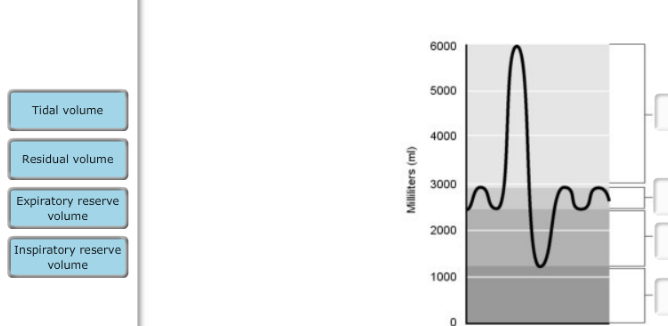
Use the figure to match the following.
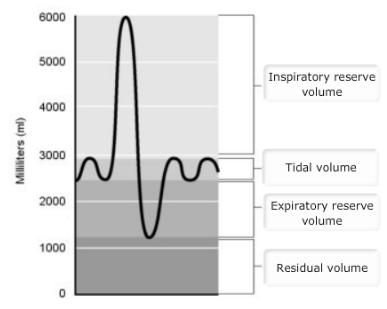
Emphysema can result in an ______.
increased level of carbaminohemoglobin
increased level of
deoxyhemoglobin
increased likelihood of the skin of Caucasians
developing a slightly blue coloration
All of the listed responses
are correct.
All of the listed responses are correct.
Possible causes of hypoxia include ________.
getting very cold
taking several rapid deep
breaths
obstruction of the esophagus
too little oxygen in
the atmosphere
too little oxygen in the atmosphere
Which muscles are activated during normal quiet inspiration?
diaphragm and internal intercostal muscles
diaphragm and
external intercostal muscles
scalenes, sternocleidomastoid, and
pectoralis minor muscles
oblique and transversus muscles
diaphragm and external intercostal muscles
Which of the following pressures must remain negative to prevent lung collapse?
atmospheric pressure
intrapleural
pressure
transpulmonary pressure
intrapulmonary pressure
intrapleural pressure
The factors responsible for holding the lungs to the thorax wall are ________.
surface tension from pleural fluid and negative pressure in the
pleural cavity
the visceral pleurae and the changing volume of
the lungs
the smooth muscles of the lung
the diaphragm and
the intercostal muscles alone
surface tension from pleural fluid and negative pressure in the pleural cavity
Which of the following gives the relationship between the pressure and volume of a gas?
Boyle's law
Haldane effect
Dalton's law of partial
pressures
Henry's law
Boyle's law
Why is a patient with tuberculosis often noncompliant with treatment?
TB infection causes damage to the nervous system, resulting in
changes in personality and judgment.
Due to the time length of
treatment, the patient may stop taking the medication when they start
to feel better.
Due to the psychological side effects of the
antibiotic used, the patient may stop taking the medication when they
start to feel better.
Due to the physiological side effects of
the antibiotic used, the patient may stop taking the medication when
they start to feel better.
Due to the time length of treatment, the patient may stop taking the medication when they start to feel better.
Which center is located in the pons?
expiratory center
pontine respirator group
(PRG)
inspiratory center
pacemaker neuron center
pontine respirator group (PRG)
Intrapleural pressure is normally about 4 mm Hg less than the pressure in the alveoli.
True
False
True
Which of the following is NOT a physical factor that influences pulmonary ventilation?
lung compliance
partial pressure of oxygen in the
air
airway resistance
alveolar surface tension
partial pressure of oxygen in the air
The paired lungs occupy all of the thoracic cavity.
True
False
False
Which of the following is NOT a function of the larynx?
to provide a patent airway
stimulation of the
"cough" reflex
to act as a switching mechanism to
route air and food into the proper channels
to assist in taste
sensation
voice production
to assist in taste sensation
Tidal volume is air ________.
remaining in the lungs after forced expiration
exchanged
during normal breathing
inhaled after normal
inspiration
forcibly expelled after normal expiration
exchanged during normal breathing
Because the lungs are filled with fluid during fetal life, which of the following statements is true regarding respiratory exchange?
Respiratory exchanges are made through the ductus
arteriosus.
Respiratory exchanges are not
necessary.
Respiratory exchanges are made through the
placenta.
Because the lungs develop later in gestation, fetuses
do not need a mechanism for respiratory exchange.
Respiratory exchanges are made through the placenta.
What part of the larynx covers the laryngeal inlet during swallowing to keep food out of the lower respiratory passages?
epiglottis
thyroid cartilage
vocal folds
glottis
epiglottis
Which of the following statements is incorrect?
Respiratory rate is lowest in newborn infants.
Descent of the
diaphragm results in abdominal breathing.
During fetal life,
lungs are filled with fluid.
The chest wall becomes more rigid
with age.
Respiratory rate is lowest in newborn infants.
What determines the respiratory rhythm in the body?
Hering-Breuer stretch reflexes
medullary respiratory
centers
pontine respiratory centers
oxygen levels in the blood
medullary respiratory centers
The major nonelastic source of resistance to air flow in the respiratory passageways is ________.
friction
surfactant
surface tension
air pressure
friction
What type of epithelial tissue forms the walls of the alveoli?
simple squamous epithelium
simple cuboidal
epithelium
stratified squamous epithelium
pseudostratified
ciliated columnar epithelium
simple squamous epithelium
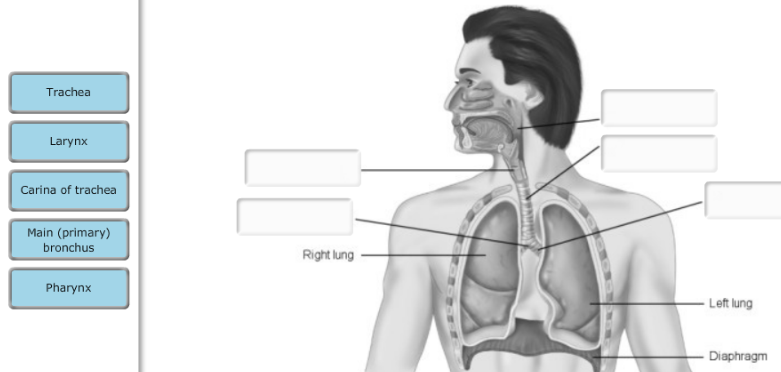
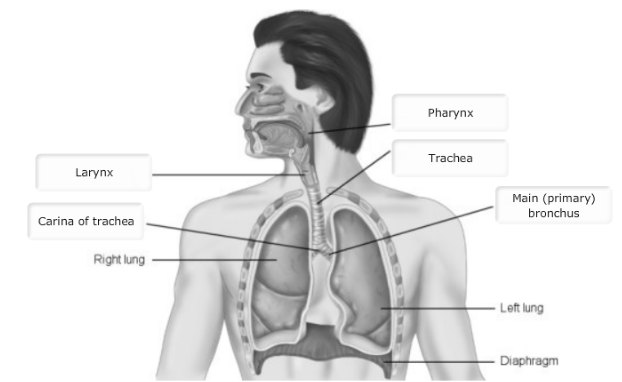
Festival 7 Digestive
Chapter 23
The major means of propelling food through the digestive tract is __________.
peristalsis
churning
segmentation
swallowing
peristalsis
In addition to storage and mechanical breakdown of food, the stomach ________.
initiates protein digestion and denatures proteins
is the only
place where fats are completely digested
is the first site where
chemical digestion of starch takes place
is the first site where
absorption takes place
initiates protein digestion and denatures proteins
Fats significantly delay the emptying of the stomach.
True
False
True
Which organ of the digestive tract is the body's major digestive organ?
large intestine
small intestine
liver
stomach
small intestine
Most digestion and absorption of nutrients occur in the __________.
large intestine
stomach
liver
small intestine
small intestine
What part of the tooth bears the force of chewing?
pulp
crown
cementum
enamel
enamel
What is the major digestive function of the pancreas?
production of bicarbonate ions
production of
insulin
production of glucagon
production of digestive enzymes
production of digestive enzymes
Which of the following is NOT a characteristic of the stomach?
The stomach releases enzymes to digest carbohydrates.
The
stomach produces a double-layered coat of alkaline mucus.
The
stomach mucosa is folded into rugae.
The stomach has three layers
of muscle in the muscularis tunic.
The stomach releases enzymes to digest carbohydrates.
Peristaltic waves are ________.
churning movements of the gastrointestinal tract
waves of
muscular contractions that propel contents from one point to
another
pendular movements of the gastrointestinal
tract
segmental regions of the gastrointestinal tract
waves of muscular contractions that propel contents from one point to another
The mucosa collapses inward when the stomach is empty, forming large folds known as __________.
rugae
cardia
fundus
pylorus
rugae
The __________ is the last segment of the small intestine.
colon
jejunum
ileum
duodenum
ileum
How would you classify chewing food?
ingestion
digestion
mechanical breakdown
propulsion
mechanical breakdown
Which of the following is not a factor that helps create the stomach mucosal barrier?
tight junctions of epithelial mucosa cells
replacing of
damaged epithelial mucosa cells
production of intrinsic
factor
thick coating of bicarbonate-rich mucus
production of intrinsic factor
The mechanical and chemical receptors that control digestive activity are located ________.
in the glandular tissue that lines the organ lumen
in the pons
and medulla
in the oral cavity
in the walls of the tract organs
in the walls of the tract organs
Chemical digestion reduces large complex molecules to simpler compounds by the process of ________.
mastication
catabolism
fermentation
anabolism
catabolism
The __________ is the serous membrane that lines the abdominal body wall.
omenta
parietal peritoneum
mesentery
visceral peritoneum
parietal peritoneum
Most gastric ulcers are due to excessive production of hydrochloric acid.
True
False
False
Impacted wisdom teeth is a problem that is never observed in children because ______.
their teeth are generally too small to become impacted
the
childhood lengthening of their jaw bones provides all of the deciduous
teeth with lots of room to erupt through the gums
they lack third
molar teeth
their wisdom teeth fall out before there is any
opportunity for them to become impacted
they lack third molar teeth
What muscle forms the labia of the mouth?
buccinator
zygomaticus
orbicularis oris
orbicularis oculi
orbicularis oris
Which of the following is NOT a structural modification of the small intestine to increase surface area?
circular folds
rugae
villi
microvilli
rugae
There are three phases of gastric secretion. The cephalic phase occurs ________.
at the end of a large meal, and the juices secreted are powerful
and remain in the GI tract for a long period of time
immediately
after food enters the stomach, preparing the small intestine for the
influx of a variety of nutrients
before food enters the stomach
and is triggered by aroma, sight, or thought
when the meal is
excessively high in acids and neutralization is required
before food enters the stomach and is triggered by aroma, sight, or thought
From the esophagus to the anal canal, the walls of every organ of the alimentary canal are made up of the same four basic layers. Arrange them in order from the lumen.
submucosa, serosa, muscularis externa, and mucosa
muscularis
externa, serosa, mucosa, and submucosa
mucosa, submucosa,
muscularis externa, and serosa
serosa, mucosa, submucosa, and
muscularis externa
mucosa, submucosa, muscularis externa, and serosa
The chemical and mechanical processes of food breakdown are called ________.
digestion
secretion
ingestion
absorption
digestion
All the chemical and mechanical phases of digestion from the mouth through the small intestine are directed toward changing food into forms that can pass through the epithelial cells lining the mucosa into the underlying blood and lymphatic vessels.
True
False
True
The __________ guards the entry of food into the stomach.
pyloric sphincter
diaphragm
cardiac
sphincter
ileocecal valve
cardiac sphincter
Festival 8 Nutrition
Chapter 24
The primary function of carbohydrates is energy production within cells.
True
False
True
Gluconeogenesis is the process in which ________.
glycogen is formed
glucose is converted into carbon dioxide and
water
glycogen is broken down to release glucose
glucose is
formed from noncarbohydrate precursors
glucose is formed from noncarbohydrate precursors
Which of the choices below describes the pathway of cellular respiration (the complete oxidation of glucose)?
lipolysis, glycogenolysis, beta oxidation
glycogenesis,
lipogenesis, electron transport chain
gluconeogenesis, Krebs
cycle, lipolysis
glycolysis, Krebs cycle, electron transport
chain, oxidative phosphorylation
glycolysis, Krebs cycle, electron transport chain, oxidative phosphorylation
Which of the following is a water-soluble vitamin?
vitamin K
vitamin B
vitamin D
vitamin A
vitamin B
What is the primary function of cellular respiration - its end-purpose?
to metabolize nutrients
to generate ATP
to produce
proteins
to oxidize glucose
to generate ATP
Which of the following nutrients yield the highest amount of energy per gram when metabolized?
fats
vitamins and minerals
foods and beverages high in caffeine
proteins
fats
The most abundant dietary lipids are ________.
phospholipids
fatty acids
triglycerides
cholesterol
triglycerides
Which term describes the breakdown of stored fats into glycerol and fatty acids?
ketogenesis
beta oxidation
lipogenesis
lipolysis
lipolysis
__________ is a substance in food used by the body to promote normal growth, maintenance, and repair.
A nutrient
A calorie
A hormone
ATP
A nutrient
In order for amino acids to be oxidized for energy, the amine group (NH2) must be removed.
True
False
True
__________ refers to reactions in which large molecules are broken down into smaller molecules.
Anabolism
Metabolism
Catabolism
Carboxylation
Catabolism
As the body progresses from the absorptive to the postabsorptive state, only the ________ continues to burn glucose while every other organ in the body mostly switches to fatty acids.
pancreas
liver
spleen
brain
brain
Which of the following food groups are considered good sources of complete proteins?
eggs, milk, yogurt, meat, and fish
corn, cottonseed oil, soy
oil, and wheat germ
egg yolk, fish roe, and grains
lima
beans, kidney beans, nuts, and cereals
eggs, milk, yogurt, meat, and fish
Cellular respiration is an anabolic process.
True
False
False
Which of the following would decrease body temperature?
eating a large meal
shivering
dilation of cutaneous blood
vessels
enhanced thyroxine release
dilation of cutaneous blood vessels
The increased use of noncarbohydrate molecules for energy to conserve glucose is called glucose sparing.
True
False
True
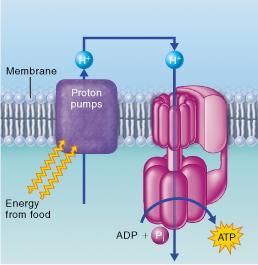
Which of the following is represented by the "membrane" indicated in the figure?
nuclear membrane
outer mitochondrial membrane
inner
mitochondrial membrane
plasma membrane
inner mitochondrial membrane
Which of the following is a characteristic of the electron transport chain (ETC)?
The electron transport chain is an anaerobic pathway.
The final
electron acceptor in the ETC is water.
NADH is a product of the
ETC.
The ETC occurs in the mitochondria.
The ETC occurs in the mitochondria.
Cholesterol, though it is not an energy molecule, has importance in the body because it ________.
is a stabilizing component of the plasma membranes and is the parent
molecule of steroid hormones
helps provide essential nutrients to
the brain and lungs
helps mobilize fats during periods of
starvation
enters the glycolytic pathway without being altered
is a stabilizing component of the plasma membranes and is the parent molecule of steroid hormones
Glycogen is formed in the liver during the ________.
starvation period
postabsorptive state
absorptive
state
period when the metabolic rate is lowest
absorptive state
The preferred energy fuel for the brain is fat.
True
False
False
The "proton pumps" indicated in the figure are physically associated with ______.
the Krebs cycle
the ATP synthase
the electron transport chain
glycolysis
the electron transport chain
Except for lactose and some glycogen, the carbohydrates we ingest are mainly from animals.
True
False
False
Which nutrients function as coenzymes and are needed in only small amounts?
electrolytes
minerals
carbohydrates
vitamins
vitamins
Neurons and red blood cells rely exclusively on __________ to meet their energy needs.
glycerol
proteins
fatty acids
glucose
glucose
Festival 9 Urinary
Chapter 25
The position of the kidneys behind the peritoneal lining of the abdominal cavity is described by the term retroperitoneal.
True
False
True
Where is filtrate produced in the nephron?
glomerulus
vasa recta
juxtaglomerular
complex
peritubular capillaries
glomerulus
Glomerular hydrostatic pressure (HPg) is the chief force pushing water and solutes out of the blood and across the filtration membrane.
True
False
True
In the kidneys, the countercurrent mechanism involves the interaction between the flow of filtrate through the loop of Henle of the juxtamedullary nephrons (the countercurrent multiplier) and the flow of blood through the limbs of adjacent blood vessels (the countercurrent exchanger). This relationship establishes and maintains an osmotic gradient extending from the cortex through the depths of the medulla that allows the kidneys to vary urine concentration dramatically.
True
False
True
Reabsorption of high levels of glucose and amino acids in the filtrate is accomplished by ________.
countertransport
passive transport
facilitated
diffusion
secondary active transport
secondary active transport
Where does antidiuretic hormone (ADH) exert its effects to promote water reabsorption?
descending limb of the nephron loop
distal convoluted tubule
(DCT)
ascending limb of the nephron loop
collecting duct
collecting duct
What two structures constitute the renal corpuscle?
renal tubule and collecting duct
glomerulus and glomerular
(Bowman's) capsule
glomerulus and renal tubule
proximal
convoluted tubule and nephron loop
glomerulus and glomerular (Bowman's) capsule
What is the function of the macula densa cells of the juxtaglomerular complex (JGC)?
The macula densa cells monitor the NaCl content of the filtrate
entering the distal convoluted tubule.
The macula densa cells
pass regulatory signals between the extraglomerular mesangial
cells.
The macula densa cells produce filtrate.
The macula
densa cells sense blood pressure in the afferent arteriole.
The macula densa cells monitor the NaCl content of the filtrate entering the distal convoluted tubule.
Which urinary structure serves as the temporary storage site for urine?
urethra
ureter
urinary bladder
renal pelvis
urinary bladder
In what part of the renal tubule are aquaporins scarce or absent so that water CANNOT be reabsorbed?
proximal convoluted tubule (PCT)
ascending limb of the nephron
loop
collecting duct
descending limb of the nephron loop
ascending limb of the nephron loop
Excretion of dilute urine requires ________.
the presence of ADH
transport of sodium and chloride ions out
of the descending loop of Henle
relative permeability of the
distal tubule to water
impermeability of the collecting tubule to water
impermeability of the collecting tubule to water
Glomerular filtration is an ATP-driven process.
True
False
False
Despite the fact that the kidney's intrinsic controls work to maintain a constant GFR, in some situations the body's extrinsic controls will work to override these intrinsic controls in order to maintain systemic blood pressure.
True
False
True
Which of the following is the functional unit of the kidney?
nephron
renal pelvis
renal corpuscle
renal pyramid
nephron
An increase in the permeability of the cells of the collecting tubule to water is due to a(n) ________.
decrease in the production of ADH
increase in the production of
aldosterone
decrease in the concentration of the blood
plasma
increase in the production of ADH
increase in the production of ADH
Which of the choices below is the salt level-monitoring part of the nephron?
loop of Henle
principal cell
macula densa
vasa recta
macula densa
The proximal convoluted tubule is the portion of the nephron that attaches to the collecting duct.
True
False
False
The entire responsibility for urine formation lies with the nephron.
True
False
True
What is the juxtaglomerular apparatus?
a system that regulates the rate of filtrate formation and systemic
blood pressure
a system that protects the nephron from some
chemicals found in blood
a system for concentrating urine
a
system for diluting urine
a system that regulates the rate of filtrate formation and systemic blood pressure
Which pressure is the chief force pushing water and solutes out of the blood and across the filtration membrane of the glomerulus?
colloid osmotic pressure in the capsular space
hydrostatic
pressure in glomerular capillaries (HPgc)
hydrostatic pressure in
the capsular space (HPcs)
colloid osmotic pressure in glomerular
capillaries (OPgc)
hydrostatic pressure in glomerular capillaries (HPgc)
The macula densa cells are chemoreceptors that respond to changes in the urea content of the filtrate.
True
False
False
If the GFR is too low, needed substances may pass so quickly through the renal tubules that they are not absorbed and instead are lost in the urine.
True
False
False
Obligatory water reabsorption involves the movement of water along an osmotic gradient.
True
False
True
In which kidney region are all renal corpuscles located?
renal pelvis
renal cortex
renal medulla
renal columns
renal cortex
The collecting duct is impermeable to water in the presence of ADH.
True
False
False
Festival 10 pH & Water
Chapter 26
What solute in body fluids determines most of their chemical and physical reactions?
electrolytes
water
glucose
nonelectrolytes
electrolytes
Respiratory acidosis results when lungs are obstructed and gas exchange is inefficient.
True
False
True
Which of the following is not a chemical buffer system?
bicarbonate
protein
nucleic acid
phosphate
nucleic acid
What is the most common cation found in the interstitial fluid?
HPO42-
Cl-
Na+
K+
Na+
One of the most powerful and plentiful sources of buffers is the protein buffer system.
True
False
True
Most acidic substances (hydrogen ions) originate as by-products of cellular metabolism.
True
False
True
Which chemical buffer system is the only important system in the extracellular fluid (ECF) that resists short-term changes in pH?
physiological buffering systems
phosphate buffer
system
bicarbonate buffer system
protein buffer system
bicarbonate buffer system
Whereas sodium is found mainly in the extracellular fluid, most ________ is found in the intracellular fluid.
bicarbonate
chloride
potassium
iron
potassium
The body's water volume is closely tied to a powerful water "magnet." What magnet is referred to here?
ionic potassium
water level in the extracellular
compartment
ionic sodium
water level in the intracellular compartment
ionic sodium
What receptors does the brain use to detect changes in osmolality?
osmoreceptors
thermoreceptors
baroreceptors
chemoreceptors
osmoreceptors
The term hypotonic hydration refers to ________.
the unpleasant feeling people have after drinking too much
liquor
the feeling one might have after profuse sweating with
exertion
a condition that may result from renal insufficiency or
drinking extraordinary amounts of water
a condition that is
caused by high levels of sodium in the extracellular fluid compartment
a condition that may result from renal insufficiency or drinking extraordinary amounts of water
The role of ADH is to __________.
decrease water reabsorption
increase water
reabsorption
produce dilute urine
lower blood pressure
increase water reabsorption
A patient's anxiety caused her to develop respiratory alkalosis. What breathing technique did the nurse recommend, and why?
The nurse instructed the patient to breathe faster and deeper. This
will increase the patient's blood levels of carbon dioxide by
eliminating less carbon dioxide from the lungs, resulting in a
decrease in the blood pH.
The nurse instructed the patient to
breathe faster and deeper. This will decrease the patient's blood
levels of carbon dioxide by eliminating more carbon dioxide from the
lungs, resulting in a decrease in the blood pH.
The nurse
instructed the patient to breathe slower and deeper, and to breathe
into a paper bag. This will increase the patient's blood level of
carbon dioxide by eliminating less carbon dioxide from the lungs, and
by breathing in the expired air which has a higher concentration of
carbon dioxide. As a result, the blood pH will decrease.
The
nurse instructed the patient to breathe more shallowly. This will
decrease the patient's blood levels of carbon dioxide by eliminating
more carbon dioxide from the lungs, resulting in a decrease in the
blood pH.
The nurse instructed the patient to breathe slower and deeper, and to breathe into a paper bag. This will increase the patient's blood level of carbon dioxide by eliminating less carbon dioxide from the lungs, and by breathing in the expired air which has a higher concentration of carbon dioxide. As a result, the blood pH will decrease.
The term alkaline reserve is used to describe the ________ buffer system.
bicarbonate
hemoglobin
phosphate
protein
bicarbonate
Which of the following does not depend on the presence of electrolytes?
amount of body fat
membrane polarity
neuromuscular
excitability
maintenance of osmotic relations between cells and ECF
amount of body fat
Select the person in the following list who would have the highest percentage of water in his or her body.
a 80-year-old man of average weight
a 25-year-old overweight
female
a 6-month-old baby boy
a 25-year-old male of average weight
a 6-month-old baby boy
As ventilation increases and more carbon dioxide is removed from the blood, the hydrogen ion concentration of the blood decreases.
True
False
True
The most abundant cation in intracellular fluid is sodium.
True
False
False
The fluid that bathes the cells found in tissues is called __________.
interstitial fluid
intracellular fluid
electrolytic fluid
plasma
interstitial fluid
Which age group most commonly has fluid, electrolyte, and acid-base balance issues?
growing children
infants
young adults
the elderly
infants
The movement of fluids between cellular compartments ________.
requires active transport
requires ATP for the transport to
take place
involves filtration
is regulated by osmotic and
hydrostatic forces
is regulated by osmotic and hydrostatic forces
The normal pH of blood is 7.35-7.45.
True
False
True
How much water is generated per day from cellular metabolism?
750 ml
1500 ml
250 ml
2500 ml
250 ml
Prolonged hyperventilation can cause alkalosis.
True
False
True
What is the effect of hyperventilation on pH?
respiratory alkalosis
respiratory acidosis
metabolic
acidosis
metabolic alkalosis
respiratory alkalosis
Festival 11 Reproductive
Chapter 27